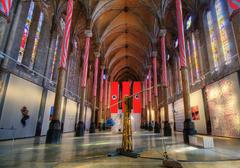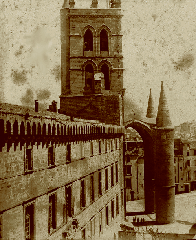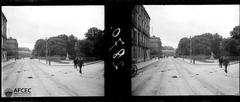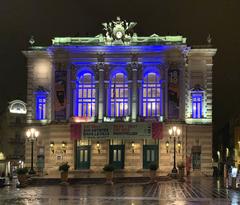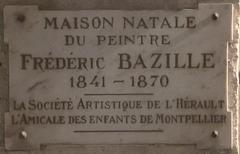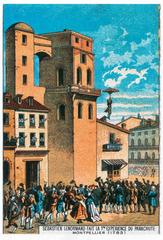Hôtel de Sarret Montpellier: Visiting Hours, Tickets, and Historical Sites Guide
Date: 03/07/2025
Introduction
The Hôtel de Sarret—also known as the Hôtel de la Coquille—is a striking testament to 17th-century French aristocratic architecture, located in the heart of Montpellier’s Écusson district. Commissioned in 1636 by Jean de Sarret, a distinguished conseiller at the Cour des Comptes, this hôtel particulier stands out for its monumental shell-shaped trompe, the largest of its kind in France. Although it remains a private residence, the building’s façades and unique architectural details are visible year-round from the street. Rare interior access is granted during select cultural events, making it a coveted highlight for history and architecture enthusiasts (Noblesse & Royautés; Lengadoc Info; Montpellier Tourisme).
This guide details the Hôtel de Sarret’s history, architectural marvels, visiting information, travel tips, accessibility considerations, and recommendations for nearby attractions. Whether you are a history aficionado, architecture lover, or a traveler eager to discover Montpellier’s noble past, this comprehensive report equips you with everything needed for a rewarding visit.
Historical Overview
Origins and Construction
The Hôtel de Sarret is among the finest examples of Montpellier’s hôtels particuliers. Initiated in 1636 by Jean de Sarret and designed by architect Simon Levesville, with masonry by Bertrand Delane, it was constructed on the site of a medieval residence. The Sarret family retained ownership until 1783, and the building’s design reflects the status and prosperity of Montpellier’s elite during the reigns of Louis XIII and Louis XIV (Noblesse & Royautés).
Architectural Layout and Materials
The structure is built around a central courtyard in a quadrilateral plan, typical of the city’s aristocratic mansions. Its two main stories (above the ground floor) utilize local limestone and traditional curved tiles. The façades, characterized by classical lines and restrained elegance, date to the 17th century (POP Culture Gouv).
The Iconic Shell Trompe
The crowning feature of the Hôtel de Sarret is its monumental shell-shaped trompe. This large corbel supports the building’s corner at the intersection of rue du Palais and rue de la Coquille. As the largest trompe de barlongue in France, it showcases 17th-century engineering and craftsmanship, with radiating voussoirs from a central boss. The shell serves both structural and decorative purposes, allowing the upper floors to project over the street and providing a visually arresting element (Lengadoc Info; POP Culture Gouv).
18th-Century Transformations
In 1783, the building underwent significant expansion. An additional story was added, and the façade was redesigned, possibly by architect d’Aviler. The original grand staircase was replaced by independent staircases, reflecting changing domestic needs. This period also saw the loss of some original decorative features, though much of the Mannerist décor remains (Monumentum).
Decorative Features and Artistic Highlights
Despite changes over the centuries, the Hôtel de Sarret retains notable elements:
- Mannerist Décor: Pilasters, acanthus-leaf consoles, arcaded doorways, and keystones with drip-mouldings.
- Shell Trompe and Courtyard Trompe: Twin architectural features showcasing technical prowess and aesthetic innovation.
- Wrought-Iron Details: Ornate balconies and railings, crafted by local artisans.
- Interior Finishes: Where accessible, visitors may observe molded plaster ceilings, marble fireplaces, parquet floors, and decorative wall paneling that speak to the refined lifestyle of Montpellier’s aristocracy.
Heritage Status and Preservation
The Hôtel de Sarret symbolizes Montpellier’s evolution from a medieval stronghold to a thriving regional capital. The building is protected as a Monument Historique—originally for the shell trompe and adjacent walls in 1935, and in its entirety since 2012 (POP Culture Gouv). Ongoing restoration ensures the preservation of its unique features and historical integrity.
Visitor Information
Location and Getting There
- Address: 6 rue du Palais (corner with rue de la Coquille), 34000 Montpellier
- District: Écusson, Montpellier’s historic city center
- Nearby Landmarks: Place de la Comédie, Musée Fabre, Cathédrale Saint-Pierre (Musée du Patrimoine)
How to Access
- Public Transport: Tram lines 1 and 3 stop near Place de la Comédie, a short walk away.
- Parking: Limited in the historic center; use Parking Comédie or Parking Esplanade.
- On Foot: Easily reached within the pedestrianized Écusson district.
Visiting Hours and Tickets
- Regular Access: The Hôtel de Sarret is a private residence. The exterior and shell trompe can be viewed from the street at any time.
- Special Openings: Interior access is offered during select cultural events such as the Festival des Architectures Vives or European Heritage Days (Montpellier Tourisme).
- Tickets: When open, tickets for guided tours typically cost €8–€15. Book in advance via the Montpellier Tourist Office website.
Accessibility
Due to its historic nature, the Hôtel de Sarret has limited accessibility for visitors with reduced mobility. The exterior and shell trompe are visible from street level. Contact the Tourist Office in advance for specific accommodations.
Practical Tips
- Plan Ahead: Guided tours sell out quickly during special events; book as early as possible.
- Language: Most tours are in French; check for English-language options.
- Clothing: Wear comfortable shoes for cobblestones and stairs.
- Photography: Permitted outside and in the courtyard during tours; follow any restrictions.
- Best Visiting Times: Spring and early autumn offer pleasant weather and coincide with cultural festivals.
Nearby Attractions
- Place de la Comédie: Montpellier’s main square, lively cafés, and shops (PlanetWare).
- Musée Fabre: Major art museum with works by Courbet and Bazille (Lonely Planet).
- Cathédrale Saint-Pierre: Iconic Gothic cathedral.
- Other Hôtels Particuliers: Such as Hôtel de Varennes, accessible during special events.
- Écusson District: Explore medieval streets, artisan shops, and traditional eateries.
Frequently Asked Questions (FAQ)
Q: Is the Hôtel de Sarret open to the public year-round?
A: No. The exterior is always visible, but interior access is only possible during special events or guided tours.
Q: How do I book a visit inside the Hôtel de Sarret?
A: Book tickets through the Montpellier Tourist Office website, especially during European Heritage Days or the Festival des Architectures Vives.
Q: What is the price for guided tours?
A: Typically between €8 and €15, with possible discounts.
Q: Is the building accessible for people with disabilities?
A: Accessibility is limited due to stairs and uneven surfaces. Contact the Tourist Office for accommodations.
Q: Can I take photos inside?
A: Photography is allowed in the courtyard and of the shell trompe, but not always inside. Always follow posted rules.
Visuals and Media
For a more immersive experience, search for images of the Hôtel de Sarret’s shell trompe and façades.
- Alt tags for SEO: “Hôtel de Sarret Montpellier shell trompe,” “Montpellier hôtels particuliers façade,” “17th-century courtyard Hôtel de Sarret.”
Plan Your Visit and Stay Connected
For updated visiting hours, ticketing, and tour information, visit the Montpellier Tourist Office website. Download the Audiala app for digital guides, maps, and exclusive content. Follow us on social media for event updates.
Summary
The Hôtel de Sarret is a jewel of Montpellier’s aristocratic and architectural legacy, famed for its monumental shell trompe and elegant classical décor. While regular interior access is limited, visitors can admire its façades and unique features from the street or join guided tours during cultural events. Strategically located in the Écusson district, it complements any exploration of Montpellier’s historic core. Advance planning and use of official resources ensure a fulfilling visit to this remarkable site (Lengadoc Info; Montpellier Heritage Monuments).
Sources
- Noblesse & Royautés
- Lengadoc Info
- POP Culture Gouv – Hôtel de Sarret
- Montpellier Heritage Monuments
- Montpellier Tourisme – Festival des Architectures Vives
- Montpellier Tourisme – Top du Patrimoine
- Musée du Patrimoine
- Grandsudinsolite
- Monumentum
- PlanetWare
- Lonely Planet
